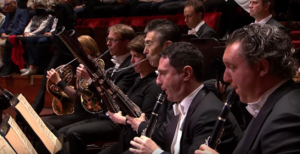Picture it: Daniele Gatti’s first concert as music director of the Royal Concertgebouw Orchestra, the beginning of the second half, the maestro descends the famous Concertgebouw staircase, when suddenly a a renegade member of the public stands to accept the audience’s applause…
…leaving us with so very many questions:
Like, is he accepting the applause on the maestro’s behalf? Or does he feel that he has done something personally to merit this ovation? He looks authoritative as he stands facing the crowd, like he was expecting this moment and he is glad to rise to the occasion. Is there a chance he thinks Gatti is a latecomer for whom he needs to make room?
I suspect we shall never know.
As much as I am amused by this moment, it’s worth pointing out a couple other things in this vid:
1. As far as conductors are concerned, right now, it’s Gatti and everyone else. He has is the reigning master. He has total control of his body, hands, and face, and every motion is nuanced and specific.
And yet, it’s never too much, never more than the musicians need. He both “looks like the music” and is there to give the musicians the support they need. He’s that rare and magical combination of what players truly want from a conductor: he gives them feeling of playing with total freedom, while in reality he is leading them with command and control.
https://youtu.be/0TkSqYvNA6s
2. The RCO sits with the clarinets and bassoons reversed (i.e. clarinets to the conductor’s right, bassoons to the conductor’s left.)

I haven’t spent much time watching the RCO, so this immediately jumped out. I looked it up in the place one goes to look up such things and it turns out it’s a remnant of the split-violin seating (firsts on the left, seconds on the right), in which the cellos and basses sit to the conductor’s left. (I imagine it might also have something to do with the Concertgebouw’s huge staircase on the right.)
I really like this, because it then allows you to seat the horns to the bassoons’ left, with the 3rd and 4th horns sitting in the back row next to the trumpets. This solves a big problem, namely that you’re always looking for a way to get the horns seated so they are part of the woodwinds as well as the brass. It’s also nice to have them seated in two rows rather than having all four lined up together – it better reflects the historical conception of the horn section, in which composers wrote for two pairs of horns in 2 different keys.
3. For the inaugural program of a new music directorship, this is… just ok. I mean Orpheus is sort of a decent enough piece I guess, but wouldn’t you put a contemporary (Dutch) composer or a thrilling soloist on the concert?
Also: is Liszt having like, a moment right now? I feel like I’m Liszt tone poems on programs all over the place. Liszt is such a messy composer – he has some really brilliant pieces, some utterly fascinating failures, and then just a whole bunch of crap (have you listened to Hunnenschlacht lately?)
4. This is a strange interpretation of the Symphonie Fantastique. I’m not totally on board, but it’s interesting, and I give Gatti full points for doing something unique and fully communicating his vision for this piece to the orchestra.
Speaking of which, nota bene: the strings are playing the symphony from photocopied, comb-bound parts. I presume these are Gatti’s parts which he has had copied for the orchestra. That’s very unusual for a professional orchestra, that the players would accept bowings/markings that are “baked in” to the page (and thus not erasable.) This doubtless made the library staff’s lives much easier though, so kudos to Gatti!